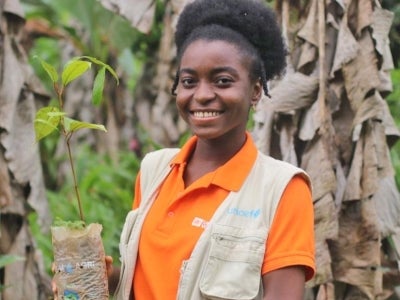
Photo courtesy of Esha Mitra
Esha Mitra is a forestry and agriculture specialist from India who divides her time between climate education and youth advocacy. In an interview ahead of the GEF Assembly, she spoke of her efforts to boost climate education and leadership in young people.
What environmental topics are you currently focused on?
I got involved in environmental education by way of agriculture and forestry studies. After I finished my bachelor’s degree in agriculture with a specialization in crop production, I obtained a master’s degree in forestry with a specialization in habitat and wildlife management. Since then, I have worked in professional and volunteer roles to educate young people about forestry and how global organizations and the international process works. I am focused on helping to build youth advocacy capacity at a regional and global level with regard to climate change.
As a global focal point for the UNCCD Youth Caucus, I work with young people from all over the world to combat desertification and improve land health. At HCL Foundation in India, I work in corporate social responsibility, helping to get environment education into schools, helping students change their attitudes and behaviors related to ecosystems, and helping to build climate leadership among young people. Through this I aim to make progress towards the Sustainable Development Goal targets of education for sustainable development, and sustainable lifestyles to build global citizenship.
What have you learned from these efforts?
When you change attitudes and behaviors, that creates long-term impact. My contribution to this started around four years back when the International Forestry Students’ Association supported my ideas and ways of disseminating knowledge about forestry topics, which opened the door to UN advocacy and work with international processes to enable youth advocacy. Now my focus is to engage, encourage, and enable young people and children to get involved in climate action. I believe this kind of continuous effort and support will result in sustainable results into the future.
If you could say one thing to today’s political or business leaders, what would it be?
Equal representation and participation of youth – irrespective of their country, region, race, gender, or sexual orientation – is vital in decision making, policy, advocacy and the implementation of environmental initiatives.
What are your other interests or hobbies?
Indigenous knowledge and Indigenous Peoples’ sustainable practices of life amaze me. Every case study I’ve reviewed has impressed me with the in-depth knowledge of sustainability in their daily lives. As a traveler, I seek to connect with local people and hear how they manage to live long and conserve nature.
Apart from this, I am a gardener, artist, and experimental cook!
What are you looking forward to at the GEF Assembly?
I believe the GEF Assembly will show us a path of inclusivity in decision making, project implementation, and policy making. This will be an interesting platform to interact with global leaders and policy makers. As a climate action leader, I hope this Assembly can be a gateway to make positive changes in international process and policy to involve climate education as well as incorporating Indigenous knowledge to bring climate action and create a climate-conscious generation for a greener, harmonious, and more sustainable future.


